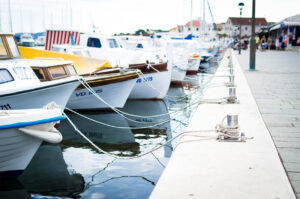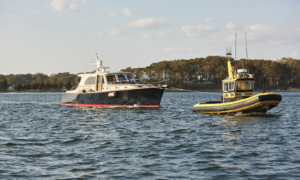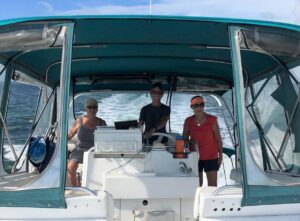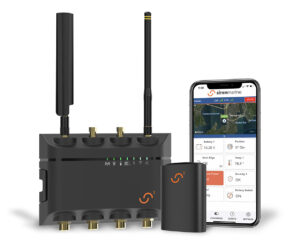Oh, how times have changed. If you look closely at older power pedestals at some marinas, you may see a connection point for a telephone and cable television. The TV jack might still be used, but not many boaters today look for a telephone dial tone through a copper wire. Today your phone and television need a strong Wi-Fi signal more than being hardwired.
Most of us use Wi-Fi today, but exactly what is Wi-Fi? In 1999, several leading technology companies came together to form the “Wi-Fi Alliance,” a nonprofit organization with the goal of creating a universally accepted protocol for a global wireless networking system. Their visionary plan has succeeded beyond anyone’s wildest dreams. The very term Wi-Fi is now understood in every language around the world, with billions of Wi-Fi devices in use.
The number of devices aboard your boat using Wi-Fi has grown exponentially over the past few years. Smart phones and tablets use Wi-Fi to connect wirelessly to chartplotters and radar. You can know the conditions aboard your boat remotely with sensors monitoring high water and battery voltage, all transmitting their information to your phone or tablet wirelessly. When aboard the boat in a marina, phones, tablets, computers and TVs connect to the outside world through a Wi-Fi network.
Which brings us to the question: Is it reasonable to expect from a marina, a fast, dependable Wi-Fi, just like they provide connections to power and water? The answer is yes, but making that a reality requires effort from the marina and the boater.
UNDERSTANDING HOW IT WORKS
The first step to better Wi-Fi is knowing a little about how it works. Wi-Fi is the technology standard used to create a wireless local area network or WLAN. It is the protocol for placing radio transceivers in your devices that allows them to share information and data wirelessly between the devices and a network.
Your devices look for a Wi-Fi signal from an access point or AP, which is the link between your Wi-Fi enabled devices and a wired network. A small marina may have a single AP on a building pointed toward the piers or a mooring field. A large marina will likely have multiple APs positioned around the marina, so each boat is near one.
TAKING CONTROL
Your ability to acquire a good Wi-Fi signal is not just dependent on the marina; you control some of that in the type of hardware you are using. If you only use individual devices like your phone, TV or your computer to access the Wi-Fi network, you are limited in the quality of your connection. The small antennas within your devices have limited ability to access signals from distant APs. Add to that the interference of all the boats and marina structures and you might get a good signal.
This isn’t necessarily the marina’s fault. The best way to access a marina Wi-Fi is to install a Wi-Fi antenna at or near the top of your boat. This antenna will have a clearer view of the marina’s AP. These antennas are also helpful or even necessary to access a Wi-Fi from an anchorage or mooring field. Your Wi-Fi antenna can then be connected to a router, creating your own mini network within your boat.
APs transmit Wi-Fi signals on varying channels. Individual devices such as phones or tablets have no way of knowing those channels or giving you the ability to select them. However, software within a router allows you to find those channels, along with the strength of the signal. Utilizing a router gives you the option of selecting the AP with the best connection and setting your system to that AP’s channel. All this increases the quality of your Wi-Fi performance.
A fringe benefit of using a dedicated router within your boat is placing an additional firewall between your information and the marina’s network. All the devices on your boat, such as TVs and printers, can now communicate with each other on your secure network.
MEASURING QUALITY
Without getting too technical, you should understand a few numbers and units of measure for getting the best Wi-Fi performance. When you think of a good quality Wi-Fi connection, you probably think in terms of speed. How fast will a page load? How quickly can you upload or download an attachment in an email?
THE MARINA’S PART
Many marinas have been slow to realize that having good Wi-Fi is no longer a luxury; it is a necessity just like power and water. To meet this need, some technology companies have become specialists in marina Wi-Fi networks.
Installing Wi-Fi in a marina environ- ment is different from a hotel or office building. Hiring a company with proven marina experience is essential to building a successful network. Also, a company that offers technical support for boaters saves the marina staff from taking technical calls outside their expertise.
SETTING EXPECTATIONS
Read reviews of a marina’s Wi-Fi service when making reservations. Ask how recently their system was installed or updated. Ask boaters about their Wi-Fi experience with other marinas. Only if marina owners hear that boaters expect a good quality Wi-Fi and when they realize it affects their business will they take seriously the investment required to offer dependable Wi-Fi service.
Fortunately, many have heard and answered with successful networks that enhance the boaters’ stay, connect to work, read a good book downloaded to your device, or stream a movie through the TV.
Wi-Fi works better when everyone does his part, when the marina offers dependable high-speed service, and boaters know how to access service in the most efficient way. This speed is measured in megabits per second or Mbps.
To get fast service over a Wi-Fi, you must first have good quality signal strength, which is measured in dBm. It is represented as a negative number from -0 to -100. That means the closer the value is to zero, the stronger the signal. For example, -40 dBm is a stronger signal strength than -60 dBm. It’s key to measuring the speed at which data is flowing and the signal strength of your connection. Free speed test apps downloaded to your smart phone or tablet make it easy to measure download and upload speeds.
Armed with this information and the proper tools enable you to make selections in your Wi-Fi connection that you cannot see connecting directly to the network with your devices. You do not need a mega yacht’s budget or a degree in computer science to install a Wi-Fi network within your boat. The cost of equipment and ease of installation continue to improve with technological advances.





